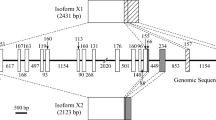Abstract
Tissue kallikrein (TK) and kinin receptors have been immuno-localized in various areas of the human nervous system, suggesting that the kallikrein-kinin system (KKS) may be functionally active in the brain. The aim of this study was to determine the cellular expression of TK and kinin B1 and B2 receptor mRNAs in specific regions of the human brain by in situ reverse transcriptase polymerase chain reaction. Autopsy samples of the brain, spinal cord, kidney and salivary gland were embedded in paraffin. Sections (5μm), adhered onto silane coated glass slides, were treated with Proteinase K and DNase, followed by reverse transcription polymerase chain reaction with specific KKS primers and digoxigenin-dUTP. Detection of the digoxigenin-label demonstrated localization of TK, B1 and B2 mRNAs in the cytoplasm of some neuronal cell bodies in the hypothalamus, thalamus, frontal cortex and spinal cord. TK mRNA was also observed in the ependymal cells lining the cerebral ventricles and epithelial cells of the choroid plexus. In the choroid plexus, only B1 gene expression was observed in some choroidal epithelial cells while no B2 labeling was detected. The identification of mRNAs to TK, B1 and B2 kinin recceptors in human nervous tissue supports previous evidence for the presence of the KKS in the brain and confirms localized protein synthesis.
Similar content being viewed by others
REFERENCES
Bhoola, K.D., Figueroa, C.D. and Worthy, K. (1992). Bioregulation of Kinins: Kallikreins, Kininogens, and Kininases. Pharmacological Reviews 44:1-80.
Bhoola, K.D. (1996). Translocation of the neutrophil kinin moiety and changes in the regulation of kinin receptors in inflammation. Immunopharmacology 33:247-256.
Chai, K.X., Ni A., Wang, D., Ward, D.C., Chao, J. and Chao, L. (1996). Genomic DNA sequence, expression, and chromosomal localization of the human B1 bradykinin receptor gene BDKRB1. Genomics 31:51-57.
Chao, J., Chao, L., Swain, C.C., Tsai, J. and Margolius H.S. (1987). Tissue kallikrein in rat brain and pituitary: regional distribution and oestrogen induction in the anterior pituitary. Endocrinology 120:475-482.
Chen, L.M., Song, Q., Chao, L. and Chao, J. (1995). Cellular localization of tissue kallikrein and kallistatin mRNAs in human kidney. Kidney International 48:690-697.
Clements, J., and Mukhtar, A. (1994). Glandular kallikreins and prostate-specific antigen are expressed in the human endometrium. J. of Clin. Endocrinology and Met. 78:1536-1539.
Clements, J., Mukhtar, A., Verity, K., Pullar, M., McNeill, P., Cummins, J., and Fuller P.J. (1996). Kallikrein gene expression in human pituitary tissues. Clin. Endocrinology 44:223-231.
Clements, J.A. (1994). The human kallikrein gene family: a diversity of expression and function. Mol. and Cell. Endocrinology 99:C1-C6.
Evans, B.A., Yun, Z.X., Close, J.A., Tregear, G.W., Kitamura, N., Nakanishi, S., Callen, D.F., Baker, E., Hyland, V.J., Sutherland, G. R., and Richards R.I. (1988). Structure and chromosomal localization of the human renal kallikrein gene. Biochemistry 27:3124-3129.
Figueroa, C.D., Worthy, K. and Bhoola, K.D. (1990). Kinins in the Brain. Human Psychopharmacology 5:183-194.
Hess, J.F., Borkowski, J.A., Stonesifer, G.Y., MacNeil, T., Strader, C. D., and Ransom R.W. (1994). Cloning and pharmacological characterisation of bradykinin receptors. Brazilian J. of Medical and Biological Res. 27:1725-1731.
Hori, S. (1968). The presence of bradykinin-like polypeptides, kinin-releasing and destroying activity in brain. Japanese J. of Physiology 18:772-787.
Jones, T.H., Figueroa, C.D., Smith, C., Cullen, D.R. and Bhoola, K. D. (1992). Tissue Kallikrein is associated with prolactin-secreting cells within human growth hormone secreting adenomas. J. of Endocrinology 134:149-154.
Komminoth, P. (1999). In situ Polymerase chain reaction Past, Present, Future. In Roche Molecular Biochemicals PCR Applications Manual (Edited by Steffen C.), p. 240-244. Roche Diagnostics, Mannheim Germany.
Ma, J.X., Wang, D.Z., Ward, D.C., Chen, L., Dessai, T., Chao, J. and Chao, L. (1994). Structure and chromosomal localization of gene (BDKRB2) encoding the bradykinin B2 receptor. Genomics 23:362-369.
Marceau, F. (1995). Kinin B1 receptors: a review. Immunopharmacology 30:1-26.
Naidoo, S., Ramsaroop, R., Naidoo, Y. and Bhoola, K. D. (1996). The status of B2 receptors in acute renal transplant rejection. Immunopharmacology 33:157-160.
Raidoo, D. M. (1999). Kinins in the human brain. PhD Thesis, University of Natal, South Africa, 149-152.
Raidoo, D.M., and Bhoola, K.D. (1997). Kinin receptors on human neurones. J. of Neuroimmunology 77(1):39-44.
Raidoo, D.M., Ramchurren, N., Naidoo, Y., Naidoo, S., Müller-Esterl, W., and Bhoola K.D. (1996a). Visualization of bradykinin B2 receptors on human brain neurons. Immunopharmacology 33:104-107.
Raidoo, D.M., Ramsaroop, R., Naidoo, S., and Bhoola, K.D. (1996b). Regional distribution of tissue kallikrein in the human brain. Immunopharmacology 32:39-47.
Shikimi, T., Kema, R., Matsumoto, M., Yamahata, Y. and Miyata, S. (1973). Studies on kinin-like substances in brain. Biochemical Pharmacology 22:567-573.
Stephenson, S.A., Verity, K., Ashworth, L.K. and Clements, J.A. (1999). Localization of a new prostate-specific antigen-related serine protease gene, KLK4, is evidence for an expanded human kallikrein gene family cluster on chromosome 19q13.3-13.4. J. of Biological Chemistry 274:23210-23214.
Wolf, W.C., Harley, R.A., Sluce, D., Chao, L., and Chao, J. (1998). Cellular localization of kallistatin and tissue kallikrein in human pancreas and salivary gland. Histochemistry and Cell Biology 110:477-484.
Wolf, W.C., Harley, R.A., Sluce, D., Chao, L. and Chao, J. (1999). Localization and expression of tissue kallikrein and kallistatin in human blood vessels. J. of Histochemistry and Cytochemistry 47:221-228.
Wu, H., Venezie, R.D., Cohen, W.M., Jenzano, J.W., Featherstone, G.L., and Lundbald, R. L. (1993). Identification of tissue kallikrein messenger RNA in human neutrophils. Agents Action 38:27-31.
Yousef, G.M., Chang, A. and Diamandis, E.P. (2000). Identification and characterisation of KLK-L4, a new kallikrein-like gene that appears to be down-regulated in breast cancer tissues. J. of Biological Chem. 275:11891-11898.
Yousef, G.M., and Diamandis, E P. (1999). The new kallikrein-like gene, KLK-L2. J. of Biological Chemistry 274:37511-37516.
Yousef, G.M., and Diamandis, E.P. (2000). The expanded human kallikrein gene family: locus characterisation and molecular cloning of a new member KLK-L3 (KLK9). Genomics 65:184-194.
Author information
Authors and Affiliations
Rights and permissions
About this article
Cite this article
Mahabeer, R., Naidoo, S. & Raidoo, D. Detection of Tissue Kallikrein and Kinn B1 and B2 Receptor mRNAs in Human Brain by In Situ RT-PCR. Metab Brain Dis 15, 325–335 (2000). https://doi.org/10.1023/A:1011131510491
Issue Date:
DOI: https://doi.org/10.1023/A:1011131510491




